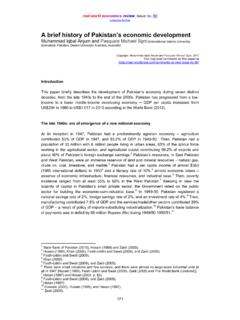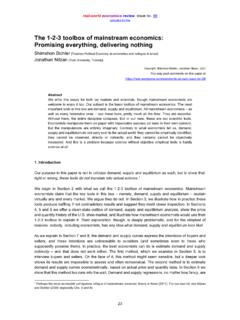Transcription of real-world economics review - paecon.net
1 Sanity, humanity and science probably the world s most read economics journal real - world economics review - Subscribers: 25,572 Subscribe here Blog ISSN 1755-9472 - A journal of the world economics Association (WEA) 14,002 members, join here - Sister open-access journals: economic Thought and world economic review - back issues at recent issues: 70 69 68 67 66 65 64 63 62 61 Issue no. 71 28 May 2015 Two proposals for creating a parallel currency in Greece A program proposal for creating a complementary currency in Greece 2 Trond Andresen and Robert W. Parenteau Updated proposal for a complementary currency for Greece (and replies to critics) 12 Alan Harvey China s communist-capitalist ecological apocalypse 19 Richard Smith Trends in US income inequality 64 Pavlina R.
2 Tcherneva The market economy: Theory, ideology and reality 75 C. T. Kurien Explaining money creation by commercial banks: 92 Five analogies for public education Ib Ravn Realist Econometrics? Nell and Errouaki s , Rational Econometric Man 112 Jamie Morgan Who does the state work for? Geopolitics and global finance 124 Tijo Salverda Board of Editors, past contributors, submissions and etc. 140 The RWER Blog - 12,000 followers and featuring Merijn Knibbe, Lars Syll, Dean Baker, David Ruccio, Peter Radford, Asad Zaman, Herman Daly and others WEA eBooks $20 each or 7 for free if you pay the $50 voluntary membership fee The Scientist and the Church Shimshon Bichler and Jonathan Nitzan The Economy of the Hamster Mauro Gallegati On the use and misuse of theories and models in economics Lars P lsson Syll Bubble economics : Australian Land Speculation 1830 2013 Paul D.
3 Egan and Philip Soos Essays Against Growthism Herman Daly Green Capitalism: The God that Failed Richard Smith Feudalism, Fascism, Libertarianism and economics Eric Zuesse Developing an economics for the post-crisis world Steve Keen Nuevos paradigmas, desarrollo econ mico y din mica social Jorge Buzaglo Statistical Foundations for Econometric Techniques Asad Zaman Wealth and Illfare: An Expedition through real Life economics T. Kurien Appreciating Mental Capital: What and Who Economists Should Also Study Robert Locke real - world economics review , issue no. 71 subscribe for free 2 A program proposal for creating a complementary currency in Greece Trond Andresen and Robert W. Parenteau [The Norwegian University of Science and Technology, Norway and and Levy economics Institute, USA] Copyright: Trond Andresen and Robert W.
4 Parenteau, 2015 You may post comments on this paper at Abstract This paper describes the concept of a national complementary or parallel currency, and the advantages of implementing it in the form of purely electronic money no bills and coins. It suggests a fairly detailed program for how a parallel or complementary currency to the euro could be introduced in a crisis-hit eurozone country, focusing on Greece. Finally, some questions and counterarguments are addressed. JEL codes: B50, E5, E42, G20, G28, H12, H62 I. Introduction The premise for the proposal to be presented in the following is that the Syriza has, at best, a breathing space of say three months to half a year before it must introduce a complementary (or parallel ) electronic currency in order to achieve macroeconomic stabilization of the Greek economy.
5 This paper is written in the recognition that even in hard-hit Greece, a majority of citizens still favour staying within the eurozone. While writing this (20 May 2015), the Greece drama is worsening day by day, and big changes may therefore occur soon. Consequently, some of the content of this paper may be out-dated by the time it is read Greece may have decided to pursue different policy strategies than is recommended below. 2. How does a complementary electronic currency (to the euro) work? Policy proposals for Greece similar to what follows have been put forth earlier by this author, for instance in (Andresen, 2010 and 2012). The additional complementary (also called parallel ) circulating medium of exchange and means of settlement to be proposed will be designated a Tax Anticipation Note (TAN), a term introduced in (Parenteau, 2015).
6 The TANs are used by the government to partly pay wages, pensions and for domestic purchases. The TAN enjoys confidence since anyone can use it to pay taxes more on this below. Transactions are done via encrypted entries through the instrument of mobile phone/SMS. These transactions are automatically received, accounted for and settled on a server with ample capacity at the country s Central Bank. Or perhaps preferably for political or legal reasons at a bank-like facility established for this purpose outside the government, from now on just called the TD: TAN Depository . Such a mobile-based transaction system may be implemented through one of the technically proven schemes already in successful operation in some developing countries, real - world economics review , issue no.
7 71 subscribe for free 3 also recently put in operation in Ecuador. The system may be implemented to work also with older models of mobile phones, since it may be SMS-based (though the main implementation will be in the form of apps for smartphones). There are no physical/paper TANs in circulation. The government has a TAN account at the TD with no limit. Like bank loans, TANs are created out of thin air as a credit to citizens, and like bank loans they are later destroyed when paid back (in settlement of citizen tax liabilities). The government account is debited whenever it pays wages or pensions, or buys goods or services. All citizens and domestic firms are automatically assigned cost-free TAN accounts at the TD. Interested foreign entities who may also face liabilities to be paid to the Greek state such as custom duties, tariffs, etc.
8 May also be offered accounts (though we will expect TANs to be used mostly by domestic agents). TANs are perpetual, zero coupon, bearer bond, so there is no interest paid to holders of TANs, and in that sense, physical cash has properties similar to a TAN. Private lending denominated in TANs is not designed as an option in the pioneer period of this system, though spontaneous peer-to -peer TAN lending will probably emerge and grow.) The government pays employees, pensioners and suppliers in a mix of TANs and euros say 20% TANs at the outset but this share should (and will) probably increase. One TAN is nominally equivalent to one euro and accepted at the Treasury in settlement of tax liabilities at 1 TAN = 1 euro. It is conceivable private market exchange will deviate from parity from time to time, but we believe there are built in stabilization mechanism inherent in TANs.
9 For example, should TANs trade at a discount to euros in private markets, Greek citizens with tax obligations (and remember, many citizens and firms have large tax arrears at the moment) can give themselves a tax cut by purchasing TANs with euros at a discount, and paying their taxes with TANs, thereby creating a demand for TANs that will reduce if not eliminate the discount through an inherent arbitrage mechanism. The mix of TAN and euro denominated government spending may be adjusted based on how the process develops. Since the TAN may be used by the public to settle tax obligations, it will likely be voluntarily accepted to a reasonable degree as a means of final settlement by many agents; both individuals and firms. TANs do not have to be officially declared legal tender to be accepted. Employees and firms offering goods and services will increasingly as the scheme gets more popular decide to accept a certain share of TANs as payment, while the rest must still be in euros.
10 While the government pays wages and taxes in the government-determined mix of TANs and euros, the mix in private sector transactions will be decided freely by the involved parties, and will differ between trades. Businesses that accept a fairly large share of TANs are likely to find that they get an in increasing market share and grow more quickly than their competitors. Notice how this sets up a first mover advantage, which should speed up the adoption of TANs as a means of final settlement in the private sector. Employers and employees may negotiate the share of wages being paid in TANs, based on private portfolio preferences and speed of adoption of TANs. Workers that accept a larger share of TANs in their wages are likely to find it easier to get a job. With regard to external trade activity, TANs should enable activation of idle labour and production capacity, thereby raising the odds that exports can increase.

















